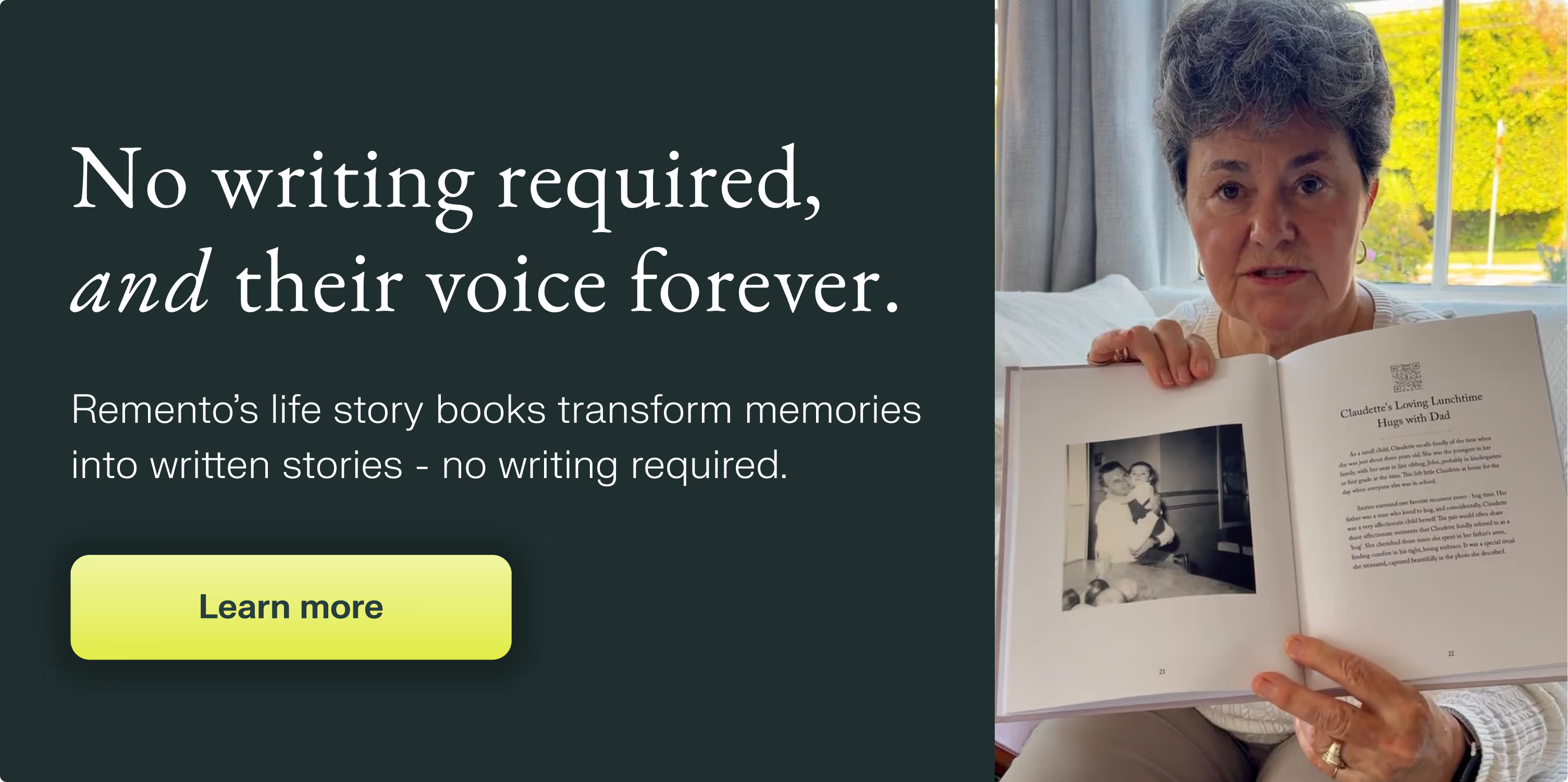Guaranteed to teach you things you never knew.
Storyworth Review – Is it Worth Buying And When to Hold Off
Uncover the strengths and weaknesses of Storyworth in preserving family memories, and explore how Remento offers a more seamless and engaging storytelling alternative for those eager to connect with their loved ones’ legacies.
Storyworth® has been around for over a decade and has carved out a recognizable name in the memory-preservation space. Its model is simple: send weekly prompts to someone you love, collect their answers over the course of a year, and compile them into a bound keepsake book.
At its best, Storyworth delivers on the promise of reflection and connection. But it also comes with real limitations: minimal customization, a text-heavy process, and a structure that can start to feel like homework. Here’s a closer look at what people love and what leaves many families frustrated.
Things People Love About Storyworth
1. Unique gift idea
Storyworth has become a popular gift for birthdays, Mother’s Day, Father’s Day, and holidays. Gifting it shows genuine curiosity about someone’s life, and many recipients are touched to know that their stories matter enough to be written down.
For families who value tradition and enjoy written expression, the format feels thoughtful and personal. Still, how meaningful the gift ends up being depends on whether the recipient enjoys writing and has the motivation to stay consistent. For natural storytellers, it can be inspiring. For reluctant writers, the excitement fades quickly.
2. A way to show you care
The rhythm of weekly prompts serves as a gentle reminder that you value someone’s experiences. Rather than a single-use gift, Storyworth encourages ongoing engagement and reflection throughout the year.
This structure can provide a sense of continuity, but it also requires discipline. Some storytellers enjoy the weekly routine, while others find the commitment difficult to maintain over time.
3. High-quality books
The finished Storyworth book is beautifully made. It’s a hardcover with consistent formatting and color photo printing, giving it a professional, timeless appearance. Families often describe the final book as durable and well-produced.
Customization, however, is limited. While you can adjust story order, choose a cover image, and make light text edits, font styles, layouts, and design elements are fixed. Every book ends up looking mostly the same, which can feel impersonal for those who want creative control.
4. Great questions
Storyworth includes a large library of prompts, from playful questions like “What was your favorite meal growing up?” to reflective ones such as “What lessons have guided your life?” For many storytellers, these prompts spark ideas and make the process feel approachable.
The limitation is that prompts are text-only and relatively static. They can be swapped out, but there’s no multimedia integration or adaptive question flow. This can make some prompts feel repetitive or less relevant over time.
Learn more: 48 Sample Storyworth Questions
5. Create a family artifact
When completed, a Storyworth book becomes a meaningful family heirloom. It preserves a storyteller’s memories in written form, offering something future generations can hold, read, and cherish.
The challenge is completion. The final product depends entirely on how many prompts are answered. The platform provides structure, but it doesn’t remove the effort required to follow through.
Things People Don’t Love About Storyworth
1. Involves writing (for most)
Storyworth is primarily a text-based platform. While the company has introduced a dictation tool that converts spoken answers into text, it does not preserve the actual voice recordings. Only the transcribed text appears in the final book, and those transcripts often need editing before they are print-ready.
For storytellers who prefer speaking to writing, or for older adults who find typing difficult, the process can feel like work rather than storytelling.
"We are in our late 70s and writing every week is just too much.” -TrustPilot Review
2. To some, feels like homework
The year-long structure with 52 prompts provides consistency, but for many people, it also creates pressure. What starts as a meaningful project can feel like an obligation over time.
This isn’t a flaw for those who enjoy structure, but it does mean the service works best for people who find satisfaction in regular writing.f.
Yeah, turns out my parents can’t do their homework either. Didn’t answer a single question for a year. - Reddit thread
3. Limited customization options
Storyworth books use a standardized design. Beyond text edits and basic photo choices, there are few options to personalize the layout. While this simplicity ensures a clean look, it can feel limiting for those who want a more creative or expressive final product.
“I was VERY...unhappy that I was stuck with double spacing...it look more like a third grade reading book.” - TrustPilot Review

4. Difficulty adding photos
Storyworth allows photo uploads, but the process can be tedious. Placement and formatting options are limited, and the interface feels basic. For storytellers who want to combine visuals and stories fluidly, the photo experience can be frustrating. Because Storyworth is entirely web-based, platform reliability is important. While most users have smooth experiences, some report losing drafts or encountering upload errors. These issues are not widespread, but they can be discouraging for users who spend time crafting stories.
“The addition of pictures is done inconsistently, especially if you add them later. If you try to add scanned input the result is also inconsistent.” - TrustPilot Review
5. Platform reliability
Because Storyworth is entirely web-based, stability is important. Most users have a smooth experience, but some have reported lost drafts, slow uploads, or occasional trouble accessing older stories. These issues are not widespread, but they do highlight the importance of saving backups and checking progress regularly.
"I wrote a long answer to the grandparents question and the program lost it. Not going to do again!" - TrustPilot Reviewer
6. Requires staying on top of email
Storyworth depends heavily on email communication. Prompts and updates arrive by email, and storytellers must check messages regularly to stay on schedule. Missing a few can mean logging into the website to catch up, which can feel like a chore for users who prefer simplicity.
"Got this for my dad.. started out great, but then all of a sudden I stopped getting his stories!" - TrustPilot Review
7. Limited family collaboration
Storyworth makes it easy for families to collect written stories over time. Each week, one question is emailed to the storyteller, who can reply directly in writing or by using voice dictation. Family members can suggest new prompts, but collaboration is otherwise limited. There’s no shared editing, commenting, or co-authoring within the platform. It’s a simple and structured experience that works best for people who enjoy writing or want to share their stories in their own words, one email at a time.
8. Time-consuming editing
Finishing a Storyworth book takes time. Even when prompts are answered regularly, the text usually needs significant polishing. Many families spend hours refining grammar, reordering stories, and aligning photos.
The dictation feature doesn’t remove this burden, since spoken answers still require cleanup before printing. For detail-oriented editors, this process can be satisfying, but others find it more time-consuming than expected.
9. Extra copies add up quickly
The $99 annual plan includes one hardcover book, but many families want additional copies for siblings, children, or relatives. Each extra book costs more, often reaching $79 or higher depending on length and color options. These costs can make wider distribution expensive for larger families.
Bottom line: Is Storyworth worth it?
Storyworth offers a structured and heartfelt way to collect and preserve family stories. Its curated prompts, clear process, and polished books make it appealing for those who enjoy writing and have the time to commit. The format provides a steady rhythm of reflection, inviting storytellers to respond week by week to meaningful questions and create a written record of their lives.
However, it’s not the right fit for everyone. The platform is best for those who find fulfillment in crafting their stories through writing, as each response is typed or dictated and printed largely as written. For others, the experience can feel repetitive or overly text-focused, and because the service doesn’t include audio recordings, it doesn’t capture the voice or emotion behind the words.
Overall, Storyworth provides a simple, text-based way to preserve family memories in print. It excels as a writing project for storytellers who appreciate structure and consistency, while those looking for a more conversational or voice-centered experience may prefer another approach.
For families interested in a more conversational approach, Remento offers an option that focuses on spoken storytelling. With Remento, storytellers record their responses, which are then transcribed and edited into written stories using its Speech-to-Story™ technology. Each printed book includes QR codes that link to the original recordings, allowing families to read the stories and also listen to the storyteller’s voice. This format emphasizes voice preservation and accessibility, offering a different experience from traditional text-based storytelling platforms.
There’s no typing, no email dependency, and no complicated website navigation. Storytellers use a single link to record from any device, while families can collaborate in real time by adding prompts or photos.
If Storyworth is for writers (or those who like to dictate their stories word-for-word), Remento is for talkers — for people who tell their best stories aloud and want them preserved just as they were told.
Learn more: Complete Comparison Guide: Remento v. Storyworth
Ready to capture stories without writing a word?
Remento uses Speech-to-Story technology to turn voice or video recordings into written narratives that are beautifully printed in a hardcover, color keepsake book. Read the book, or scan the QR codes inside to hear the original recordings.
Learn more: Remento

Their stories, forever at your fingertips
Remento’s life story books turn a parent or grandparent’s memories of the past into a keepsake book for the future - no writing required.
Capture priceless family memories today
Join the thousands of families using Remento to preserve family history, all without writing a word.
.avif)
